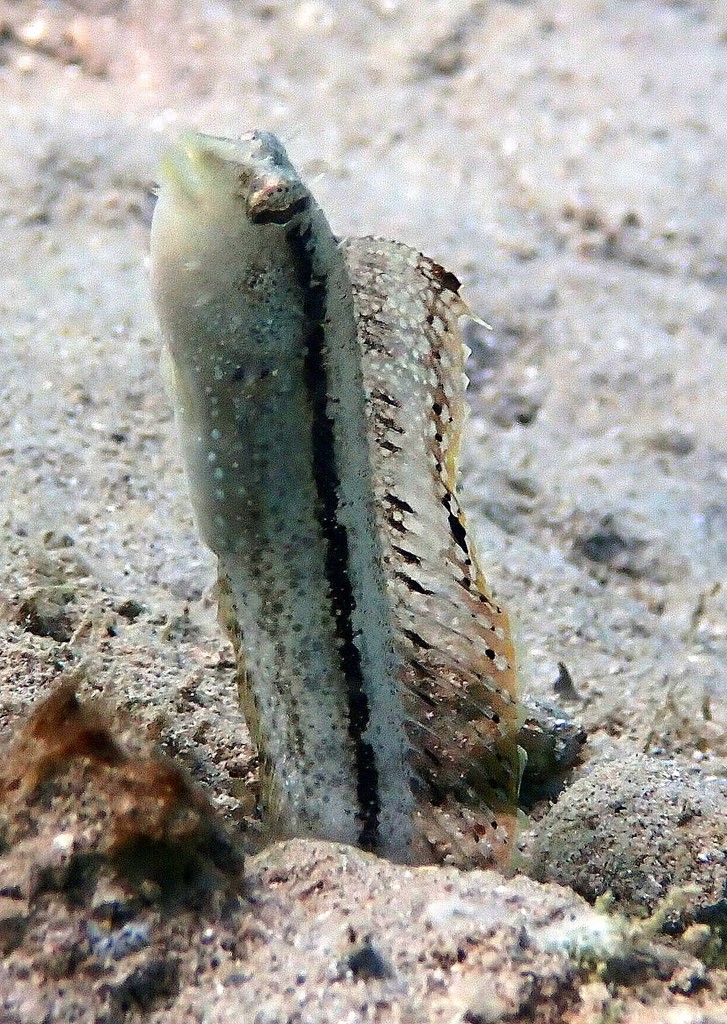PETROSCIRTES XESTUS - (JORDAN & SEALE, 1906)
Picture courtesy of: Claire Goiran
Actinopterygii (Gigaclass) > Actinopteri (Class) > Teleostei (Subclass) > Blenniiformes (Order) > Blennioidei (Suborder) > Blenniidae (Family) > Blenniinae (Subfamily) > Petroscirtes (Genus)
Blennie brillante à dents de sabre, Bearded sabretooth blenny, Bearded sabretooth blenny, Smooth sabretooth blenny, Smooth fangblenny, 光跳岩鳚,
Synonymes
Petroscirtes pindae (Smith, 1959)
Petroscrites xestus (Jordan & Seale, 1906)
----------------------------
Description
Dorsal spines (total): 10-11 (1st spine shorter than 2nd and 4th spines; 2nd spine may be elongate in males); Dorsal soft rays (total): 14-16; Anal spines: 2; Anal soft rays: 14-16; Pectoral fins rays: 13-15. Premaxillary teeth: 17-30; Dentary teeth: 19-32. Symphysial dentary cirrus multifid, with 8-26 filaments. Supratemporal pores: usually 5. Posterior nostril with short flap on front rim. Max. length: 7.5 cm TL. Depth range: 0 - 12 m.
Color
Head and body mottled, brownish and speckled, usually with narrow dark stripe dorsolaterally along body; Dorsal fin with series of small black spots submarginally (in life, bordered above and below by blue spots), pupil-sized black spot submarginally over spines: 9-11, and often with small black spot distally on first spine; No dark spot near base of outer pelvic fin rays.
Etymology
Petroscirtes: from Ancient Greek, pétra = stone, rock + from Greek, skirteo = to jump. Referring to Rüppell’s claim that Petroscirte mitratus was seen jumping between rocks out of the water hunting for small amphipods; However, since Petroscirte mitratus is not amphibious, Rüppell may have confused it with Alticus saliens, observing both blennies at Jubal Island (Egypt, Red Sea) and thinking they were conspecific.
xestus: latinization of the Greek adjective, xestós = smoothed, polished. Referring to coloration of dorsal surface of head of juvenile type, “bright silvery, as if coated with mercury,” and/or broad silvery lateral stripe from eye to base of caudal fin.
Original description: Petroscirtes xestus Jordan & Seale, 1906 - Type locality: Pago Pago, American Samoa.
Distribution
Indo-West Pacific: East Africa (Mozambique), Maldives and Chagos Archipelago (British Indian Ocean Territory), east to Micronesia, Line Islands (Kiribati) and Samoa, north to Philippines, south to northern Australia and New Caledonia.
Biology
Adults occur solitary usually over sandy areas of reef flats and shallow lagoons. Small juveniles were found below the upside-down jelly Cassiopea that moves over sandy substrates providing safe travel. Eggs are attached to the substrate via a filamentous, adhesive pad or pedestal. Females nest in empty mollusk shells. Larvae are planktonic, often found in shallow, coastal waters. Oviparous, distinct pairing.
Similar species
Petroscirtes thepassii (Bleeker, 1853) - Reported from Indo-West Pacific: Indonesia, Papua New Guinea, Solomon Islands, Palau, Yap and Chuuk.
Petroscirtes variabilis (Cantor, 1849) - Reported from New Caledonia - Link to the species (here).
Last update: 23, August 2024
Actinopterygii (Gigaclass) > Actinopteri (Class) > Teleostei (Subclass) > Blenniiformes (Order) > Blennioidei (Suborder) > Blenniidae (Family) > Blenniinae (Subfamily) > Petroscirtes (Genus)
Blennie brillante à dents de sabre, Bearded sabretooth blenny, Bearded sabretooth blenny, Smooth sabretooth blenny, Smooth fangblenny, 光跳岩鳚,
Synonymes
Petroscirtes pindae (Smith, 1959)
Petroscrites xestus (Jordan & Seale, 1906)
----------------------------
Description
Dorsal spines (total): 10-11 (1st spine shorter than 2nd and 4th spines; 2nd spine may be elongate in males); Dorsal soft rays (total): 14-16; Anal spines: 2; Anal soft rays: 14-16; Pectoral fins rays: 13-15. Premaxillary teeth: 17-30; Dentary teeth: 19-32. Symphysial dentary cirrus multifid, with 8-26 filaments. Supratemporal pores: usually 5. Posterior nostril with short flap on front rim. Max. length: 7.5 cm TL. Depth range: 0 - 12 m.
Color
Head and body mottled, brownish and speckled, usually with narrow dark stripe dorsolaterally along body; Dorsal fin with series of small black spots submarginally (in life, bordered above and below by blue spots), pupil-sized black spot submarginally over spines: 9-11, and often with small black spot distally on first spine; No dark spot near base of outer pelvic fin rays.
Etymology
Petroscirtes: from Ancient Greek, pétra = stone, rock + from Greek, skirteo = to jump. Referring to Rüppell’s claim that Petroscirte mitratus was seen jumping between rocks out of the water hunting for small amphipods; However, since Petroscirte mitratus is not amphibious, Rüppell may have confused it with Alticus saliens, observing both blennies at Jubal Island (Egypt, Red Sea) and thinking they were conspecific.
xestus: latinization of the Greek adjective, xestós = smoothed, polished. Referring to coloration of dorsal surface of head of juvenile type, “bright silvery, as if coated with mercury,” and/or broad silvery lateral stripe from eye to base of caudal fin.
Original description: Petroscirtes xestus Jordan & Seale, 1906 - Type locality: Pago Pago, American Samoa.
Distribution
Indo-West Pacific: East Africa (Mozambique), Maldives and Chagos Archipelago (British Indian Ocean Territory), east to Micronesia, Line Islands (Kiribati) and Samoa, north to Philippines, south to northern Australia and New Caledonia.
Biology
Adults occur solitary usually over sandy areas of reef flats and shallow lagoons. Small juveniles were found below the upside-down jelly Cassiopea that moves over sandy substrates providing safe travel. Eggs are attached to the substrate via a filamentous, adhesive pad or pedestal. Females nest in empty mollusk shells. Larvae are planktonic, often found in shallow, coastal waters. Oviparous, distinct pairing.
Similar species
Petroscirtes thepassii (Bleeker, 1853) - Reported from Indo-West Pacific: Indonesia, Papua New Guinea, Solomon Islands, Palau, Yap and Chuuk.
Petroscirtes variabilis (Cantor, 1849) - Reported from New Caledonia - Link to the species (here).
Last update: 23, August 2024
